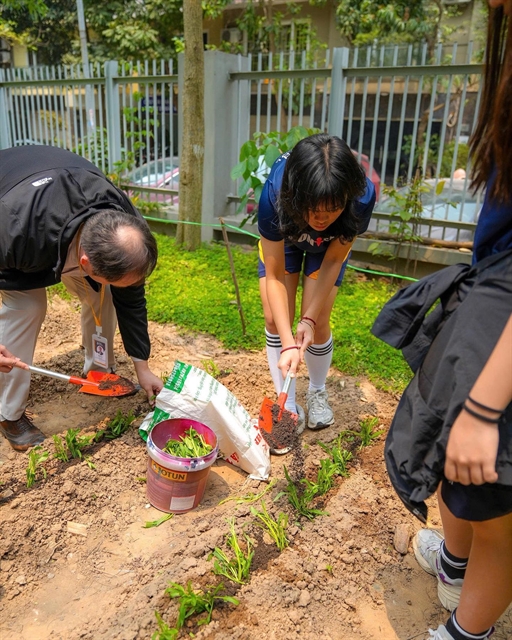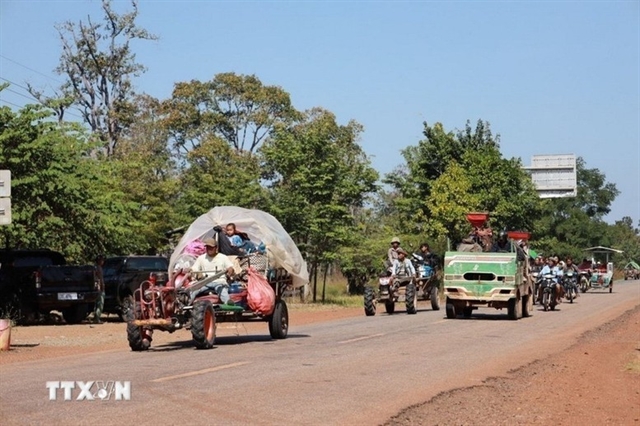 Environment
Environment

Salinity and droughts will come earlier and be more severe in the 2019-20 dry season than the previous year in the Mekong Delta, according to Hoàng Phúc Lâm, Vice Director of the National Centre for Hydro-Meteorological Forecasting.

|
| Local police officers and residents in the Central Highlands province of Đắk Lắk use an iron pile to fix a section of the Quảng Điền dyke system that broke yesterday due to prolonged heavy rain. VNA/VNS Photo Tuấn Anh |
HÀ NỘI Salinity and droughts will come earlier and be more severe in the 2019-20 dry season than the previous year in the Mekong Delta, according to Hoàng Phúc Lâm, Vice Director of the National Centre for Hydro-Meteorological Forecasting.
The rainy season in the Central Highlands and southern regions will last until October, with a high risk of low pressure and storms that go along with heavy rains, he said.
According to Lâm, from August to October, the main flow of the Mekong River is likely to stay lower than the average level of most years by 10-30 per cent.
Due to a lack of rainfall and low upstream flow in the Mekong River, the flood spike in 2019 in the Mekong Delta region will be lower than the average level of many years, with the peak of flood season falling in the first half of October, he said. The lower upstream flow is also likely to lead to elevated risk of drought and early salinity in the Delta.
Regarding the recent flooding on Phú Quốc Island in Kiên Giang Province as well as in the Central Highlands and southern regions, Lâm explained strong southwest winds combined with an inter-tropical convergence zone in the East Sea led to prolonged rains and high rainfall in the regions.
He noted that in the city of Buôn Mê Thuột in the Central Highlands province of Đắk Lắk, total rainfall in the first 10 days of August was 402mm, much higher than the average level in the same period of many years of about 111mm.
In Phú Quốc, the rainfall in the first 10 days of August was 1,167mm, seven times higher than the average level of only 163mm, and equivalent to one half of the average level on the island for the whole year of about 2,800mm. This was a record level of rainfall for the island since 1978, he said.
Dyke break
A five-metre section of Quảng Điền dyke system in Central Highlands Đắk Lắk Province’s burst due to prolonged heavy rains, according to Vice Chairman of Krông Ana District’s People’s Committee Nguyễn Minh Đông yesterday.
Floodwater from the Krông Ana river overflowed and destroyed more than 1,000ha of rice due to be harvested.
Local authorities mobilised all available resources to fix and strengthen the dyke, using thousands of sandbags to hold back the water.
The system, built at a cost of VNĐ300 billion (US$13 million), opened in 2014.
Support for flood victims
The Vietnam Red Cross Society (VRCS) will offer Central Highlands and southern localities that were affected by the recent torrential rains and floods more than VNĐ600 million ($25,800) to help them recover.
A VRCS team led by their Vice President Trần Thị Hồng An will be sent to Phú Quốc island District in the Mekong Delta province of Kiên Giang to deliver the relief aid today.
Earlier on Monday, in the southern Đồng Nai Province, another team led by VRCS President Nguyễn Thị Xuân Thu offered cash and necessities worth more VNĐ121 million to affected locals.
Another team reached Da Teh District of the Central Highlands province of Lâm Đồng to assess damage in the locality and provide aid worth VNĐ210 million to the community.
Through assessments, the team will compile a report and make a proposal to the International Federation of Red Cross and Red Crescent as well as organisations and donors to ask for assistance.
Support teams have also gone to Central Highlands Đắk Lắk and Đắk Nông provinces to provide aids to flood-stricken residents. VNS




